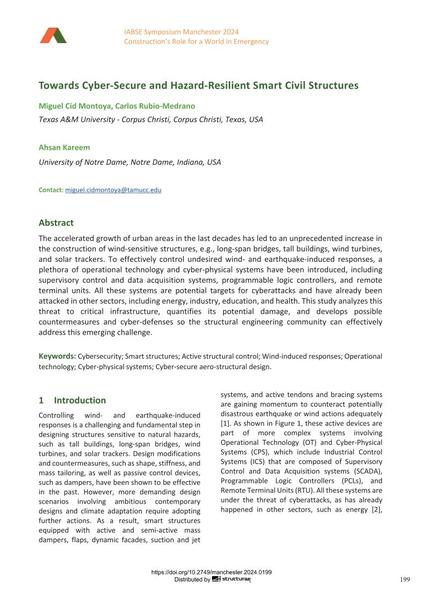Towards Cyber-Secure and Hazard-Resilient Smart Civil Structures

|
|
|||||||||||
Détails bibliographiques
| Auteur(s): |
Miguel Cid Montoya
(Texas A&M University - Corpus Christi, Corpus Christi, Texas, USA)
Carlos Rubio-Medrano (Texas A&M University - Corpus Christi, Corpus Christi, Texas, USA) Ahsan Kareem (University of Notre Dame, Notre Dame, Indiana, USA) |
||||
|---|---|---|---|---|---|
| Médium: | papier de conférence | ||||
| Langue(s): | anglais | ||||
| Conférence: | IABSE Symposium: Construction’s Role for a World in Emergency, Manchester, United Kingdom, 10-14 April 2024 | ||||
| Publié dans: | IABSE Symposium Manchester 2024 | ||||
|
|||||
| Page(s): | 199-207 | ||||
| Nombre total de pages (du PDF): | 9 | ||||
| DOI: | 10.2749/manchester.2024.0199 | ||||
| Abstrait: |
The accelerated growth of urban areas in the last decades has led to an unprecedented increase in the construction of wind-sensitive structures, e.g., long-span bridges, tall buildings, wind turbines, and solar trackers. To effectively control undesired wind- and earthquake-induced responses, a plethora of operational technology and cyber-physical systems have been introduced, including supervisory control and data acquisition systems, programmable logic controllers, and remote terminal units. All these systems are potential targets for cyberattacks and have already been attacked in other sectors, including energy, industry, education, and health. This study analyzes this threat to critical infrastructure, quantifies its potential damage, and develops possible countermeasures and cyber-defenses so the structural engineering community can effectively address this emerging challenge. |
||||
